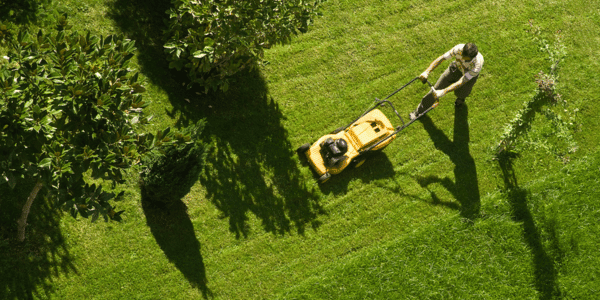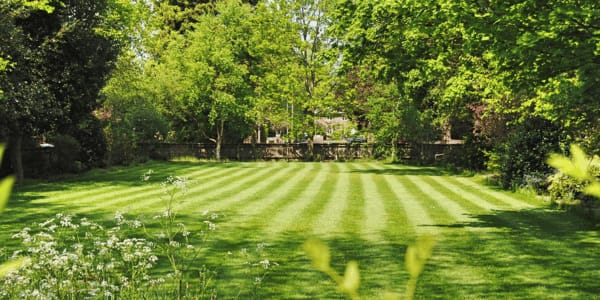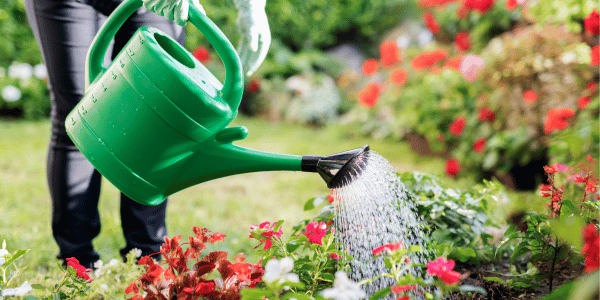Mow Like a Pro: Grass Cutting Tips & Tricks

Whether you enjoy it or try your best to avoid it, mowing your lawn is a necessary part of being a homeowner. The mowing process seems simple, but properly maintaining your grass isn’t as cut and dry as you may think. Follow our grass cutting dos and don’ts and lawn mowing tips to learn how to mow your lawn like a pro!
DO: Mow your lawn at the right time of day.
Do you wake up on the weekends and constantly wonder: What time can I start mowing my lawn? Well, you should mow your lawn between 8:00 AM and 10:00 AM. This morning window is ideal because you won’t disrupt your neighbors, run into dewy grass, or overwork yourself in the heat. As always, if you live in a homeowners’ association (HOA), review your community’s rules for approved mowing times before revving up the engine.
DON’T: Mow wet grass.
Always confirm your grass and soil are dry to the touch before mowing. Cutting grass when wet can clog your mower, damage the soil, and inhibit growth. As a rule of thumb, you should wait until morning dew evaporates, two to four hours after light rainfall, and one to two days after heavy rainfall.
DO: Know what kind of grass you have.
Believe it or not, there are over 10,000 types of grass—and each one should be treated differently. Find out your grass type and ensure it’s appropriate for your region. From there, research the best ways to care for it, from when to cut to how to water it and everything in between. For example, some types will need to be cut more frequently, while others will need close mowing to stay healthy and avoid thatch buildup, a layer of dead and almost-dead grass that can hamper growth.
Popular Grass Types by Region
- Northwest: Kentucky Bluegrass
- Northeast: Tall Fescue and Kentucky Bluegrass
- Midwest: Tall Fescue and Buffalograss
- Southeast: Zoysiagrass and St. Augustine Grass
- Southwest: Bermudagrass, Buffalograss, and Kentucky Bluegrass
Related Content: Tree Trimming 101: What to Do & What to Avoid
DON’T: Forget proper clothing.
It may feel right to mow your lawn in shorts and sandals, especially in summertime, but if you’re putting safety first, you’ll want to wear the proper protection.
What to Wear When Mowing Your Lawn
- Eye protection, like safety goggles or sunglasses.
- Hearing protection, like earplugs or headphones.
- Protective footwear, preferably sturdy, closed-toed shoes or work boots.
- Gloves, specifically ones designed for yard work.
- Close-fitting clothing with long sleeves.

DO: Vary your lawn mowing patterns.
Everyone has their preferred mowing style. Some people move their machine in a crisscross pattern, while others mow in waves or ripples. However, experts recommend alternating between a variety of patterns for the best care. Switching things up will lead to a more even cut and prevent patchy areas. It’s also a great way to learn new techniques and try unique looks for your lawn.
DON’T: Cut your grass too short.
You want your grass to have an average blade height of about three inches. Aim to cut before your grass is four and a half inches tall, and when you do mow, never remove more than one-third of your leaf tissue. Cutting grass too short can weaken roots, slow recovery, and encourage weed growth.
Common Grasses and Their Heights:
- Augustinegrass: 2-4 inches
- Buffalograss: 2-3 inches
- Bentgrass: .25-.75 inches
- Bermudagrass: .50-1.5 inches
- Buffalograss: 2-3 inches
- Centipedegrass: 1.5-2.5 inches
- Fine Fescues: 1.5-2.5 inches
- Kentucky Bluegrass: 1.5-2.5 inches
- Ryegrass: 1.5-2.5 inches
- Tall Fescue: 2-3 inches
- Zoysiagrass: .50-1.5 inches
DO: Use your grass clippings.
While your instinct may be to pitch your grass clippings, it’s actually good to spread the excess around. This cut grass naturally puts water and nutrients into the soil when it decomposes, increasing moisture retention, decreasing soil temperature, and helping your grass grow back in a stronger, healthier fashion. Use clippings with mulch for an additional boost.
Related Content: 5 Ways to Spruce Up Your Backyard on a Budget
DON’T: Let your blade get dull.
Periodically inspect your grass-cutting tools, especially your mower, making sure the blades stay sharp, balanced, and clean. Instead of slicing, dull blades shred and tear the grass. This can cause discoloration, disease, and other damage that can reverse all your hard work. A yearly sharpening can thwart these issues and provide neat cuts and a smooth mow.
Beyond Grass Cutting: More Summertime Lawn Care Tips
Grass cutting is an important part of summer lawn care, but it’s not the only thing you should be doing to beautify your outdoor space. Between taking care of plants, keeping things hydrated, cleaning up after pets, and so much more, there are a few items you should have on your outdoor maintenance to-do list. Check out our “7 To-Dos for a Fresh and Fabulous Summertime Lawn” to get all the details on what you should get done.
FAQs
When to start cutting grass?
Grass cutting should start in the early springtime. Your grass should be actively growing and at least three inches tall.
What month do you stop cutting grass?
You should begin to slow down your grass-cutting around October. In most places, by November, temperatures will be cool enough to stop cutting until spring. The pros say to stop cutting your grass once high temperatures fall under 50°F consistently.
How much to charge for cutting grass?
If you’re considering starting a grass-cutting business, most active professionals charge $50-$250 for each job.
How to start a grass-cutting business?
Starting a grass-cutting business is a multi-step process that requires:
- Figuring out what specific services you want to offer
- Purchasing the correct equipment
- Promoting your services
- Getting the right licenses, insurance, etc.

